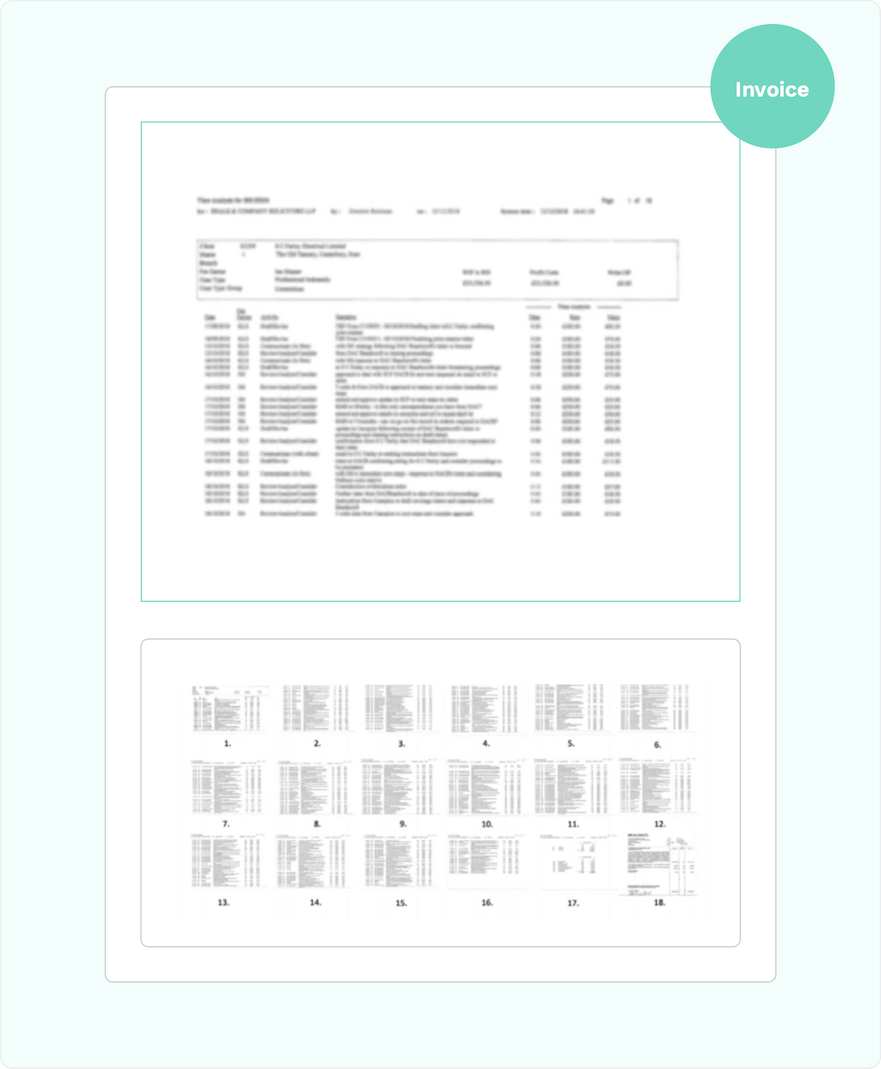The Benefits of Legal Spend Management Software
Corporate finance is going through a fundamental transformation: CEOs are increasingly looking to this function for input on decisions driving the organization’s growth.
Detailed forecasts, accurate reports, and instant insights are now expected rather than applauded. And as a result, finance teams have been making significant investments in technology capable of automating business spend management.
So why are legal departments still insisting that they need a separate tool?
This article aims to answer that question by explaining the unique challenges legal spend presents and highlighting the corresponding solutions made possible by a specialized legal spend management platform.
Understanding the Unique Challenges of Legal Spend
Unpredictable by Nature
A company’s legal requirements rarely translate into neat and predictable business expenses. Unforeseen changes to variables like industry regulations, market developments, and project scope can instantly throw forecasts into disarray. A litigation matter that unexpectedly arises in March, for example, could consume your annual budget by July.
Additionally, legal spending is only weakly correlated with revenue or staffing. This is very different from other types of business expenses, such as equipment purchases, which are easier to project based on obvious organizational traits.
These same factors also complicate the timely and accurate reporting of accrued but unbilled work — a pain felt deeply by finance teams within publicly traded companies. With incomplete knowledge of which firms are actively working on legal matters, some won’t even know who to ask to submit accruals. (And that’s all before the accuracy of those projections is even considered.)
Complicated by Hourly Billing
Most law firms still use an hourly billing model, leaving in-house legal teams with little clarity on the true nature (and value) of services provided. While most legal invoices offer detailed summaries, often down to the minutes spent on each activity, translating this unstructured data into actionable insights is cumbersome if not impossible.
Compared to the simple, fixed-fee invoices associated with most goods and services, legal invoices can be exponentially longer and denser.

Difficult to Enforce Guidelines
In-house legal teams generally establish guidelines at the start of outside counsel engagements to define what is and is not a valid, billable service. These regulations range from the straightforward, such as aligning task difficulty with staff seniority, to the more nuanced, such as what kind of research activities are within scope. The end product is effectively an addendum that clarifies the terms and conditions of purchase.
Because most legal work is billed on an hourly basis, and because the correct application of these guidelines depends on careful analysis of dozens of pages of context, in-house legal teams typically end up spending an hour or more reviewing each individual invoice. And while corporate finance tools automate review workflows and payment processing, they cannot interpret the content of legal invoices them- selves. As a result, they leave the most labor-intensive challenge unaddressed.
Difficult to Evaluate
Standard corporate finance software can reliably provide simple reports such as spend by law firm or spend by quarter. These tools struggle, however, to answer more impactful questions like:
- Which of our law firms has been most cost-efficient for a certain set of tasks?
- How consistently is our newest firm adhering to our billing guidelines?
- Was the rate they billed abnormally high for that type of matter?
This knowledge gap has left most legal departments in a position where prestige and loyalty continue to be the primary factors driving law firm selection. Not surprisingly, that’s made overspending, retention of subpar business partners, and internal dissatis- faction common experiences1.
How The Right Technology Can Transform Legal Spend Management
To effectively address the unique challenges of legal spend, the ideal solution would have to help teams:
- Easily set and track budgets
- Significantly reduce invoice review time
- Accurately enforce billing guidelines
- Consistently ensure accurate and timely financial reporting
- Instantly provide insights that inform strategic decisions
So which technical capabilities would you need to achieve those business outcomes?
Clear, Customizable Budgeting
Given the unpredictable nature of legal spend, cost clarity should be the first job for any solution you choose. By plainly tracking spend against budget, you’ll establish the financial scoreboard by which all future strategies and activities are judged. Not all tools measure with equal precision, however.
Standard corporate finance software only tracks legal spend in the most general sense. Unable to grasp the full context lying inside law firm invoices, these systems struggle to generate deeper insights such as spend by litigation phase, for example.
A dedicated legal spend management platform gives the gift of granularity. Budget controls can be automated by matter phase and/or time period to suit the specific needs of your teams. And if you ever have to update budgets on the fly, the software can create an audit trail for complete accountability.
This newfound transparency alone has been proven to fundamentally change working relationships between legal and finance for the better. But it also sets the stage for a number of other impactful innovations.
Intelligent Invoice Review
Invoice review remains the single most time-consuming element of financial manage ment for most in-house legal teams. But how can technology increase efficiency without reducing accuracy?
Let’s consider the questions your colleagues are likely asking themselves when manually reviewing invoices:
- Does this task comply with our billing guidelines?
- Are the total fees within the agreed upon budget?
- Was the work performed necessary and appropriate?
- Am I authorized to approve the invoice?
Legal spend management software accelerates this process by automatically answering many of the more basic, repetitive questions and freeing your team to focus on the more complex, subjective issues. This approach is only valuable, though, if you can trust the technology to make the correct decisions. That’s where artificial intelligence (A.I.) comes in.
At the most fundamental level, A.I. systems learn by repeatedly studying the relationships between various inputs and outputs. As their judgment improves, they can eventually predict the correct output for a given input. And since budgets, billing guidelines, and approval workflows are all based on consistent input-output rules, they represent ideal training environments for A.I.
Here’s what that means in practice. An A.I.-assisted invoice review process starts when a law firm submits an invoice in either LEDES or PDF format. The software then rapidly reads every line of narrative description (“input”) to learn its meaning and assign an industry-standard code (“output”).
Next, it checks each legal service against established billing guidelines. If there are no billing violations, then the invoice is automatically approved. If there are simple billing violations such as missing descriptions, then the software automatically rejects the invoice. If the billing violations are more complex, then they are flagged for human review by an in-house legal professional.
The end result is a process that reduces administrative work, maintains (or improves) billing guideline compliance, and reserves your attention for only the most challenging items.
Finance-Friendly Reporting
Clarity and control are the first capabilities to establish, but the financial activities at hand will also need to be recorded in highly-regulated ways. For most teams, that means extra emphasis on accruals management and tax compliance.
Accruals Reporting
This process has traditionally been defined by legal staff combing through spread- sheets every few weeks to capture the estimates supplied by their law firms. The resulting delays and inaccuracies frequently cause friction between in-house attorneys, financial administrators, and the partner firms.
Legal spend management platforms are specifically designed to address these frustrations. From simplified submission workflows to snapshot views of real-time budget progress, a 100% compliant legal spend reporting process is now within reach.

Tax and Entity Compliance
Tax compliance is one big reason legal spend management becomes exponentially more challenging once companies start operating in multiple countries. Tax rates, as well as business customs, can vary widely between regions.
Whether attorneys submit invoices in PDF or LEDES format, a legal spend management software should be able to quickly determine whether they applied the correct tax code. This helps flag incorrect calculations at the start of the process, eliminating the need for time- consuming corrections after the invoices reach finance. You can also specify which currencies each business entity supports to ensure only the correct currencies are billed in the first place.
Compliant invoices, on the other hand, can be automatically recorded in your finance systems of record via an integration. As a result, legal spend quickly conforms to your existing financial reporting structures without any extra effort.
Other Financial Reporting Capabilities
There are several simpler, but no less important, financial controls to consider as well. These include verifying that invoices reference a valid purchase order and enforcing an approval workflow that respects your organization’s delegation of authority.
Legal spend management platforms not only provide these capabilities, they also integrate with your finance systems of record to ultimately increase speed and enhance visibility.
Accessible, Actionable Data
Over the long term, the most valuable aspect of a legal spend management platform will be the insights generated after processing millions of invoice line items. Translating these narrative descriptions into structured data suddenly reveals patterns and perspectives that few legal teams have ever seen. And filtering strategic decisions through this new layer of objectivity can create dramatic competitive advantages.
Consider the ability to instantly access data on blended rates, spend by firm, or matters by practice area, for example. Identifying and retaining the most cost-efficient firms would be easier than ever. Alternatively, you might spot an area where hiring an in-house attorney actually makes the most fiscal sense.
These are just a few specific scenarios; your own creativity is the only true limit to the analytical potential of the technology. And as the platform continues to process more matters and spend over time, the confidence you have in your conclusions will steadily increase as well.
Conclusion
As corporate finance teams continue to take more proactive roles in guiding organizational strategy, the calls for consistent cost control, accurate reporting, and timely insights are only growing louder.
And while the embrace of digital technology has opened new doors in recent decades, the standard financial software suites used by most enterprises still represent a solution that was never truly intended to address the problem of managing legal spend in the first place.
The emergence of specialized legal spend management software offers a future both sides can support. The technology still prioritizes thoughtful financial forecasting, strict vendor management, and clean reporting practices — just in a way that honors the unique realities of legal services. And given the modest implementation and training requirements associated with such a platform, your teams could start enjoying all the advantages outlined in the previous pages within one business quarter.
So if and when your legal department starts seriously considering a legal spend management software purchase, keep this guide close and use it to thoroughly evaluate what that investment could bring to your business.



